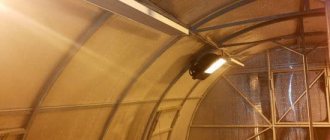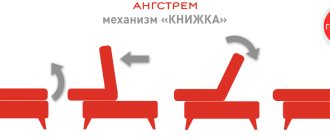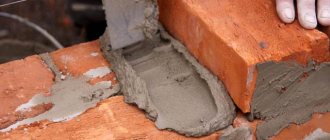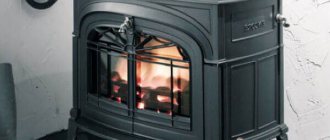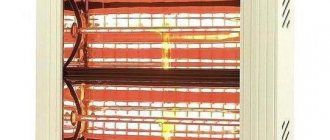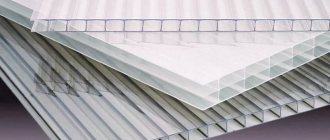The best devices for heating a greenhouse are infrared heaters.
Infrared heaters for a polycarbonate greenhouse have the ability to heat the soil and planted plants without heating the air in the room itself. This happens with the help of electromagnetic waves. This makes it possible to grow useful crops inside the greenhouse around the clock. They are also more cost-effective and efficient than other heating systems.
How does an IR heater for a greenhouse work?
The operation of the heater is associated with the energy released by electromagnetic waves in the range of infrared rays.
Each type of wave has its own length, so they differ as:
- Short;
- Distant;
- Average.
The equipment used in greenhouses has its undoubted advantages.
Equipment advantages:
- It is ergonomic, and even for a fairly large area of 10 square meters you will need a device with a power of up to 500 W;
- This is an absolutely harmless heating method; such radiation has a positive effect on plant growth, enhancing their taste and beneficial properties;
- Infrared heaters are easy to use and equipped with control devices;
- The heating process can be automatic, thanks to additional equipment with controllers;
- Operation is related only to the availability of an electrical network.
Heaters can be placed on the ceiling of the greenhouse - when the waves cover the entire interior space of the room, the warm air mass cannot rise upward.
Thus, the soil and plants are uniformly heated without heat loss, and the floor of the greenhouse always remains warm, even in winter.
Rating of the best heaters for greenhouses
| Nomination | place | Name of product | price |
| The best floor-mounted infrared heaters for a greenhouse | 1 | Ballu BIH-LM-1.5 HC-1136144 | 3290 ₽ |
| 2 | Heatphone ERGPA-0.7 | 3189 ₽ | |
| 3 | Polaris PKSH 0508H | 4600 ₽ | |
| 4 | Zenet NSKT-90B | 3550 ₽ | |
| The best wall and ceiling infrared heaters for a greenhouse | 1 | NeoClima Shaft-2.0 | 3170 ₽ |
| 2 | Hyundai H-HC7-20UI291 | 5290 ₽ | |
| 3 | Timberk TIR HP1 1800 | 5700 ₽ | |
| 4 | Ballu BIH-CM-2.0 | 3700 ₽ | |
| 5 | Timberk TCH A5 1000 | 3450 ₽ | |
| 6 | Almac IK11 | 4290 ₽ | |
| The best heat guns for a greenhouse | 1 | Tropik-Line TPP5 (4.5 kW) | 7940 ₽ |
| 2 | Hyundai H-HG2-03-UI503 | 2429 ₽ | |
| 3 | Wester TB-3/5 (3 kW) | 2550 ₽ | |
| 4 | Ballu BHP-P2-3 Limited Edition | 3990 ₽ | |
| 5 | Timberk TIH RE8 2M (2 kW) | 3000 ₽ |
Differences between infrared ceiling heaters for greenhouses
Ceiling devices are most in demand as they provide proper heating of the area. They are safe for any type of greenhouse covering, be it film or glass. And much more efficient than gas-based heating systems.
Heaters differ in different incandescent elements:
- The simplest is considered to be a tubular heater made of aluminum plates;
- A tungsten filament in a quartz case conducts and distributes heat very well;
- Carbon fiber absorbs a minimum of electricity and has excellent heat dissipation, but is quite fragile and has a high cost;
- Micathermic plates show good results when used in greenhouses, but are too expensive;
- A good option would be heating based on ceramic heaters; they consume a minimum of electricity and are resistant to humidity and different temperatures.
In most cases, models are equipped with a thermostat, with which you can create ideal conditions for the growth of various plants.
You should choose the most durable models, characterized by a long service life, and equipped with a regulator.
And the most popular means of heating a home is a heated floor. All the details are in our article: https://homeli.ru/stroitelstvo-doma/inzhenernye-sistemy/kanalizatsiya/sterzhnevoj-teplyj-pol
Features of heating a greenhouse with an infrared heater according to installation methods
Infrared heating devices are portable and stationary. The latter are more efficient.
Among them there are 3 types of devices:
- Wall-mounted heating structures mounted on a vertical surface. The model can be placed in any convenient place.
- When purchasing heating systems placed on the floor, it is better to opt for carbon and tubular options.
- The most convenient are ceiling film structures. They save free space in the greenhouse and cover the entire area well. Mounting method: on brackets.
When using the greenhouse seasonally, heating is used from above, that is, from the ceiling. If crops need to be grown early, it is better to use underfloor heating.
When the goal is to operate the greenhouse all year round, you can combine different types of infrared heating. Conveniently, all types use ordinary electric current, so there is no need to think about other sources.
It is worth remembering that ceramic heaters are not particularly durable, and, moreover, may not be safe for human health.
We offer you an overview of the most popular heating devices. All information is on the next page:
Selecting quality IR equipment
A large assortment of goods and its various characteristics make you think about which product to buy.
Important recommendations when purchasing:
- First you need to decide on the number of IR lamps. If you decide to use them in conjunction with a water or gas heater, you will need much fewer devices.
- If it is not established what the power should be, you can consult the seller;
- The product must be properly packaged and a quality certificate must be attached to it.
- Functionality must be checked in the store. In this case, you should pay attention to the presence of noise. The device may be faulty.
- When purchasing, you must have a warranty card for services and a receipt.
Different heaters may have their own operating characteristics, and the buyer should be warned about this.
Productive heating of a polycarbonate greenhouse with an infrared heater
When it comes to a greenhouse intended for winter growing of flowers and vegetables, a polycarbonate sheet or honeycomb material is usually used for the covering. For such a greenhouse, you can choose any heating, since the material itself already creates a fairly comfortable level of the climatic environment.
Different heating systems for this design have their pros and cons:
- If you take a gas convector, then it has superiority in heating speed, but in this case the ventilation system of the building must be seriously thought out. Gas equipment is extremely easy to install and can also be easily moved from one area of the greenhouse to another.
- To heat with water heating you will need to lay pipes. In addition to purchasing equipment, such a system can dry out the air and distribute heat unevenly. In addition, installation of a foundation will be required.
- Despite the fact that in winter it will take quite a lot of electricity to provide infrared equipment, it is one of the best ways to heat a winter greenhouse.
However, if you place infrared light lamps wisely, you can save a lot of electricity. For example, in a square greenhouse you can place lamps in four corners and this will be quite enough for their productive work. In addition, such devices protect the room from drafts.
Cost-effectiveness, aesthetics and simplicity of design are the advantages of an infrared heater. Read about it in our material:
Selecting the right model
The design of the IR heater for a greenhouse itself consists of ceramic emitters located in a metal frame. The internal metal must be properly polished and resemble a mirror sheet. Such greenhouse designs are good because their rays imitate the sun, so the plants feel great even in the cold season.
In this case, heat is absorbed by walls, ground and other objects, and then transferred to the air.
Another feature is the ability to heat large areas if the heater is moved away from the ground. In this case, the heating temperature will decrease and the area will increase.
It is worthwhile to carefully approach the purchase of a heater for a greenhouse
. In addition to these advantages, IR heaters have a number of other advantages:
- Ideal heating of the area. Compared to conventional heaters, where hot air rises and cold air falls, IR heaters work evenly around the entire perimeter. When hot air is at the top, this is not a plus for plants, and IR units warm up objects, so vegetables receive the required level of heat.
- Practicality of use. It is possible to install several heaters in different zones, each of which will have its own set temperature. This will allow you to plant certain plants in one of the temperature zones and provide them with the necessary warmth. This, in turn, is a cost-effective model, since electricity is used only in the required quantity. With proper settings, you can save up to 40% energy.
- With such a heating system, drafts are completely eliminated, and heat loss will be minimal, since the equipment can be installed near windows.
In this video you will learn how to choose an infrared heater:
Using the experience of gardeners, we can determine some Recommendations for choosing the required model of IR heaters:
- According to observations, using infrared structures, you can get up to 40% more yield.
- IR rays do not dry the air, so their use eliminates the need for additional air humidification.
- There are no unpleasant odors, and work takes place without unnecessary noise.
- The earth warms up to a depth of 6-8 cm. Such indicators cannot be achieved using other devices.
- The design and functionality allow you to warm the ground up to 27 degrees, while the air temperature will not exceed 20 degrees.
From this we can conclude that IR devices are indispensable for a greenhouse in the winter season. You also need to know certain features of IR rays:
- lighting devices can heat up to 600 degrees, which is a great advantage for using them on an industrial scale;
- long-wave devices cannot heat up to such a temperature, so they are well suited for small rooms;
- Some models can also run on gas, but most are powered by electricity.
Effective heating of a greenhouse with an infrared heater: reviews and tips
Infrared emitters are especially in demand for growing early crops. Consumer opinion about this heating method is mostly positive. However, there are some subtleties when using different types of IR equipment.
Reviews from greenhouse owners indicate that wave technology is chosen due to its main advantages:
- Naturalness of the heating process;
- Quick payback of the structure.
It is noted that the efficiency of using infrared lamps increases when used in combination with other heating systems. This applies to year-round operation of greenhouses.
Based on user experience, it is advisable to purchase equipment with protection against vertically dripping water (IPX 1).
In order not to damage the coatings, including those made of polycarbonate, it is important that reliable heat-insulating material is used in the greenhouse.
Excess electricity will not be consumed if an IR ray reflector is simultaneously used when operating ceiling emitters.
The only regret is that there are too few high-quality domestic IR heaters, and foreign analogues are too expensive.
Heating tapes for heating the soil in greenhouses ENGL-1-TK
Heating tapes ENGL-1-TK are used for heating the soil in greenhouses. The use of this type of heating helps in solving such problems
- Protecting plants from frost
- Increasing ripening time
- Extending harvest time
- Possibility of growing heat-loving crops
- Increased yield
Heating tapes for heating soil ENGL-1-TK
is a very reliable heating system that has such useful functions and advantages as the ability to turn on even at low temperatures, forced heating, protection against inrush currents, and a sealed shell.
Calculation of heater parameters for laying heating tape ENGL-1-TK
Let's say we have a greenhouse with dimensions of 3 by 6 m, in which the area for planting plants is about 15 m2. The required heating power is calculated using the formula:
Power = Area * Recommended power = 15 m2 * 60 W/m2 = 0.9 kW
Thus, we select a tape with suitable power from the table of standard models. In this case, the most suitable model is ENGL-1-TK - 0.92 with a power rating of 920 W and a length of 11.68 m. You can also take two heaters of lower power of 460 W each.
Installation of ENGL-1-TK in a greenhouse
Before installation, it is necessary to remove about 40 cm of soil and level the surface on which the tape will be laid. Sand is poured onto a flat surface in an even layer of about 3 cm, after which it must be well watered and compacted. A heating tape is laid on the sand in the center of the beds; the distance between the heating elements should not be more than 0.5 m. Next, another 2 cm layer of sand is laid and also watered.
The end of the heater with the thermostat placed on it is installed on top of the sand layer, after which a fine-mesh metal mesh is laid to protect the tape and the thermostat with sensors. The removed part of the soil is returned on top of the structure.
Buy ENGL-1-TK from the Polimernagrev company
You can call us directly by phone or place an order on the website through the application form.
Delivery
We deliver the goods “Heating tapes for heating the soil in greenhouses ENGL-1-TK” through TC Business Lines or other transport companies throughout the Russian Federation and the CIS countries. We will quickly deliver your goods from a warehouse in Stupino, Moscow region to cities such as: Moscow, St. Petersburg, Orel, Novosibirsk, Ekaterinburg, Nizhny Novgorod, Naberezhnye Chelny, Murmansk, Tyumen, Minsk, Ryazan, Mytishchi, Volgograd, Astana, and as well as other cities in Russia and the CIS, where there are offices of carrier companies.

